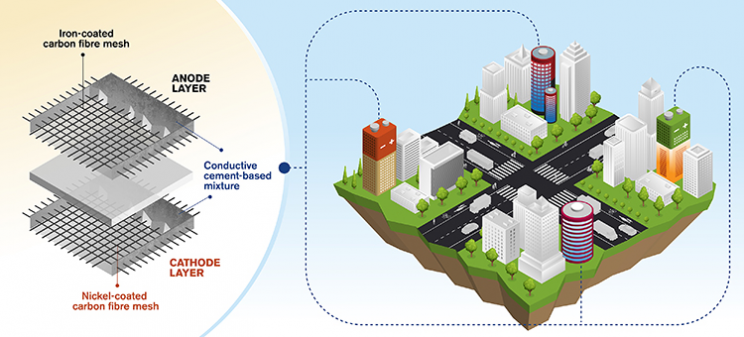One of the areas where renewable energy has great potential is in repurposing entire urban spaces to hide components in plain sight. A novel example is outlined in a new study by researchers at Chalmers University of Technology (CUT), who presented a new cement-based battery that could form the building blocks of entire structures to store energy harvested by renewables.
While researching how to reduce the carbon footprint of concrete, the team at CUT drew from previous work on concrete as a means for power storage — such as the work done by the SoftBank-backed Energy Vault.
Rechargeable concrete building blocks
The team devised a cement-based mixture with the addition of small amounts of short carbon fibers in order to increase the conductivity and flexural strength of the material. The researchers also incorporated a metal-coated carbon-fiber mesh, using iron for the anode, and nickel for the cathode of the battery.
The team claims that previous models of concrete batteries performed poorly and that their new mixture’s improved performance makes it a world first.
“Results from earlier studies investigating concrete battery technology showed very low performance, so we realized we had to think out of the box, to come up with another way to produce the electrode. This particular idea that we have developed – which is also rechargeable – has never been explored before. Now we have proof of concept at lab scale,” Emma Zhang, study author, explained in a press statement.

The CUT team’s concrete-based battery does, indeed, have a relatively strong performance. The researchers said that tests showed the battery has an energy density of 7 Wh per square meter of material (or 0.8 Watthours per liter) — 10 times more than previous concrete battery solutions, the CUT scientists said.
That’s not to say it’s quite ready for commercialization as the current performance is much lower than commercial batteries. However, the CUT team did argue that large-scale buildings made out of the material could counter the limited capacity due to their size.
New innovations to power the world’s smart cities
The CUT team did note that their research is in its very early stages. One issue that will have to be resolved, for example, is the fact that concrete buildings have an incredibly long lifespan, not matched by batteries.
“Since concrete infrastructure is usually built to last fifty or even a hundred years, the batteries would need to be refined to match this, or to be easier to exchange and recycle when their service life is over. For now, this offers a major challenge from a technical point of view,” Emma Zhang said.
Despite the drawbacks, the CUT team has already envisioned use cases for concrete battery storage. The team explained that the technology could one day be used to allow for multi-story buildings that essentially double up as massive energy storage facilities. Perhaps the development could also lead to a re-emergence, or a variation, of the divisive style of brutalist architecture, with its exposed concrete facades.
“We are convinced this concept makes for a great contribution to allowing future building materials to have additional functions such as renewable energy sources,” Luping Tang, another member of the CUT team, explained.
Pairing this technology with other solutions — such as the James Dyson Sustainability Award-winning AuREUS solar panels that could potentially turn the windows of large buildings into constant energy generators — does have the potential to turn entire cities into massive harvesters of renewable energy.
The new development from CUT joins a long list of promising technologies, with inevitable caveats, that could one day power the smart cities of the future at the same time as meeting the necessary climate goals.






More Stories
The Oracle 9i OCA and OCP Certifications Are Being Retired – What Does That Mean to Me?
Myth Busted: Cell Phone Tower Radiation Does Not Cause Harm
The Science Of Psychology – An Oxymoron?